mobile View, to the German Version tap the flag


- Khanate of Khiva
- former Turkestani state
- historic Empire of Khorezm, existing between the 4th cent. B.C. and ca. 1400
- other names: Khwarezm, Khorezm, Khorezmia, Khwarizm, Khwaresm
• Flags
• Meaning/Origin of the Flag
• Map
• Numbers and Facts
• History
• Origin of the Country's Name

11th–19th cent.,
Flag of Khorezm/Khiva,
Source, thanks to: Faruk Tezer




1873–1918,
Flag of the Khanate of Khiva,
Source, by: Wikipedia (EN)



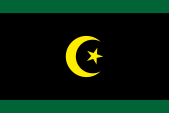
1918– Jan. 1920,
Flag of the Khanate of Khiva,
Source, by: World Statesmen



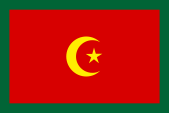
to April 1920,
Flag of the Khanate of Khiva,
ratio = 2:3,
Source, by: World Statesmen



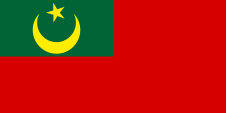
to July 1922,
Flag of the Khorazmian People's Soviet Republic,
ratio = 1:2,
Source, by: World Statesmen



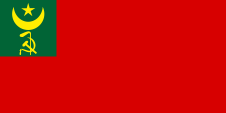
July 1923 to October 1923,
Flag of the Khorazmian People's Soviet Republic,
ratio = 1:2,
Source, by: World Statesmen



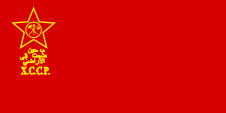
October 1923 to October 1924,
Flag of the Khorazmian Socialist Soviet Republic,
ratio = 1:2,
Source, by: World Statesmen




The old empire of Khorezm used a single-coloured black flag. The colour should have its roots in Calif Abbas I. Until today the colour black stand for the Abbasids, Abbas I. and his descendants, on flags in the arabic-islamic world. After Khiva became a Russian protectorate, there was introduced a single-coloured white flag, which showed in the upper staff quadrant a blue half-moon. The colour white should probably symbolize the peaceful intentions toward Russia, blue is the colour of the Turk nations and Tatars. In the short phase of independence had been used two other flags. Its mutual symbolism had been half-moon and star, the symbols of Islam but even of the Turks. The flag between the years 1918 and 1920 was single-coloured black, a return to the old tradition, and showed above and below green borders, other sources also show a completely surrounding green border. The model of 1920 showed already the communist red instead of black. The flag of the Far Eastern Republic showed a red bunting how it was usual for Soviet republics. A square green upper corner initially showed a crescent moon and a star for three months, later hammer, sickle and scythe were added and that motif was used for a year. Until the accession to the Soviet Union there was a completely red flag from October 1923, which showed the communist symbolism, the country name in Arabic and the initials of the country in Cyrillic in the upper corner in gold.
Source:
Wikipedia (EN),
Wikipedia (D),
World Statesmen,
Volker Preuss

Empire of Khorezm in the 6th century:
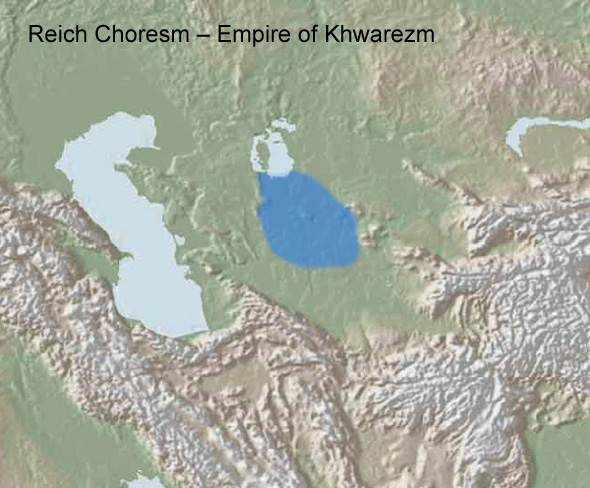
Source: University of Texas Libraries, modyfied by: Volker Preuss
Turkistan about 1870:
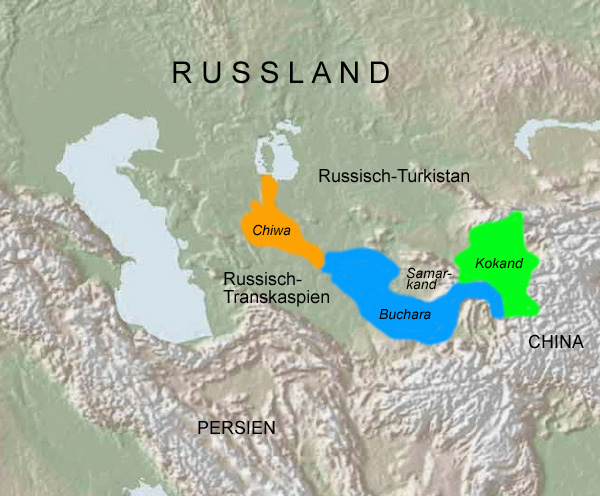
Source: Freeware, University of Texas Libraries, modyfied by: Volker Preuss

Area: 22.316 square miles
Inhabitants: 700.000 (1885), thereof in 1920 ca. 65% Uzbek, 27% Turkmen, 4% Kara-Kalpak, 3% Kazakh
Religions: 99% Sunni Muslim (1914)
Density of Population: 31 inh./sq.mi. (1885)
Capital: Khiva, 6.000 inh.. (1885)
official Languages: Uzbek, Turkmen
other Languages: Toijik, Kirghiz, Karakalpak, Persian
Currency: 1873-1918 Russian Ruble, 1918-1920 Khiva Tenga, 1920-1923 Soviet Khiva Ruble
Source:
Meyers Konversationslexikon via
RetroBib Retrobibliothek,
World Statesmen

antiquity · settlement by Iranian nations
5th century B.C. · province of the Persian Empire, later independent Kingdom of Khorezm
5th century A.D. · immigration of Turk nations, Khorezm has to pay tribute
751 · Arabian conquest, islamization
1043 · conquest by the Selchuks
ca. 1090 · Kuthb Eddin Mohammed becomes Shah of Khorezm as proconsul of the Selchuks, bigest deployment of power of Khorezm
1194 · withdrawal of the Selchuks
1220 · conquest by the Mongols under Dshingis Khan and his successors, later incorporation into the Empire of the Golden Horde
1372, 1373, 1376 · invasions of Timur
1379 · conquest by Timur, demolition of the capital, decline of the empire
1388 · invasion of Timur
1484–1511 · to Persia
15th century · migration of Uzbeks (named after Ösbek Khan, a ruler of the Golden Horde) under the leadership of Abulkhair Khan
1511 · conquest by the Uzbeks under Ilbars Chan, establishment of the Khanate of Khorezm
1620 · transfer of the capital from Urgench to Khiva
1700–1715 · vassal of Russia
1740–1792 · conquest by the Persian Nadir Shah, reign of Kirghiz Khans
1792 · the Uzbek Mehemmed Emin Inag banishes the Kirghiz, re-establishment of the Uzbek power under a new dynasty, as country's name, the name "Khanate of Khiva" is spreading abroad and partly also locally, but the official name is and remains "Khanate of Khorazm"
1839 · Russian attempt to conquest
March–May 1873 · conquest by Russia
12th of August 1873 · treaty between Khiva und Russia, Khiva becomes a Russian protectorate and has to cede all territories northern Amudaria River to Russia Russland (Kenka Area)
1917 · bolshevist coup d’état in Russia, followed by a civil war which began in Soviet Russia, lasted until 1920 and was victorious for the Bolsheviks, followed by the establishment of Soviet rule over the entire territory of the former Russian Empire, from which the Soviet Union emerged in 1922
13th of February 1917 · the Khanate of Khiva declares its independence
9th of April in 1919 · Soviet Russia recognizes the independence of the Khanate of Khiva
1st of February in 1920 · Soviet Russian troops occupy the country
26th of April 1920 · proclamation of the Khorazmian People's Soviet Republic
13th of September in 1920 · Union agreement with Soviet Russia, the sovereignty of Khorazm is confirmed
1920–1925 · Basmachi Rebellion led by Junaid Khan against the Soviet rule
20th of October in 1923 · proclamation of the Khorazmian Socialist Soviet Republic
27th of October in 1924 · accession to Soviet Union
17th of February in 1925 · divided between Soviet Russia (RSFSR), Soviet Turkmenistan and Soviet Uzbekistan
Source:
Meyers Konversationslexikon via
RetroBib Retrobibliothek,
Wikipedia (D),
World Statesmen

The name "Khiva" has its roots in the same named town. The old name of the country is "Khorezm" what means "Country of the Lowland" and refers to the estuary of Amudaria River. Capital of Khorezm was Urgench. About 1620 the capital became transfered to Khiva Town.
Source:
Meyers Konversationslexikon via
RetroBib Retrobibliothek


![]()
























